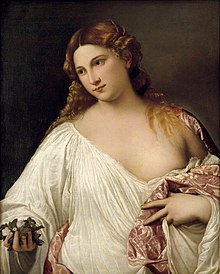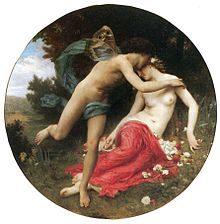User:Esbeals/Flora (Titian)

| Esbeals/Flora | |
|---|---|
| Artist | Titian |
| Year | 1518 |
| Medium | Oil on canvas |
| Dimensions | 79.7 cm X 63.5 cm |
| Location | Uffizi Galley, Florence |
Flora is an oil painting done on canvas by Italian late Renaissance painter Titian.[1] The work was begun in 1516 and completed in 1518.[2] It may have been commissioned by Alfonso I d'Este, the Duke of Ferrara, and is now held in at the Uffizi Gallery in Florence, Italy.[2] Though the exact identification of the subject is disputed, the painting undeniably depicts an idealized woman in the half-length portraiture style.

History
The work was reproduced in numerous 16th century etchings.[1] The painting's mythological subject matter is echoed in paintings such as Rembrandt's Saskia as Flora, which depicts Rembrant's wife, Saskia, as the Greek goddess, Flora.[3] In 1793, the work returned to Italy from Vienna during an art exchange between the Imperial Belvedere Gallery and the grand dukes of Tuscany.[1]
Flora has been emulated by artists such as Palma Vecchio, who utilized the type in his Portrait of a Courtesan and A Sybil.[4]
Provenance

After the completion of the painting in 1528, it may have been owned by Alfonso I d'Este.[2] In 1637, it was acquired by Spanish Ambassador, Alfonso Lopez, who owned it until approximately 1639.[2] At this time, the painting was sold to Archduke Leopold Wilhelm of Austria. Under the Archduke, the painting entered the Hapsburg collection in 1728.[2] It remained in the Hapsburg collection until 1793, when it was acquired by the Galleria degli Uffizi.[2]
Description
Flora portrays an idealized beautiful woman, a model established in the Venetian school by Titian's master Giorgione with his Laura.[1] She rests in front of a dark brown background, which contrasts with her pale skin and white chemise, causing her to appear luminous. Her left hands holds a pink-shaded mantle, while another holds a handful of flowers and leaves. Her white chemise falls off of her left shoulder, partially exposing her breast, a symbol of fertility. Her head is tilted, and she gazes to the left, away from the viewer. This positioning is traditional in that the subject does not engage with the viewer. Female renaissance portraiture was generally meant to celebrate the beauty of the figure, not her intellectual capabilities.[5] Her diverted gaze also manages to convey the idea of modesty despite the painting's general tone of pleasure and attraction.[5]
The identification of the woman in the painting is disputed. Some identify the woman as a courtesan, while others consider her a mythological figure.[1] The identification with Flora, the ancient goddess of flowers and fertility, derives from the presence of Spring flowers in her hands.[6] These flowers include violets, roses, and jasmine.[1]
Titian's Flora is represented with many trademark characteristics of feminine beauty associated with the 16th century: pale skin, rosy cheeks, dark eyebrows, red lips, and red-golden hair.[7] This hair color was typical of Titan, and he used it in many of his portraits such as his Madonna and Child. As such, the color came to be known as Titian Red.[1]

Iconography
Though the identity of the woman in this portrait is uncertain, some have identified her as Ovid's Flora, bride of Zephyr, who was one of the Greek wind gods.[1] According to Ovid, Zephyr saw and pursued a nymph called Chloris. He later proceeded to rape her. Afterward, the nymph transformed and became the goddess Flora. Ovid describes these events in his poem, Fasti.[6]
The woman in the portrait has also been identified as a courtesan, and the painting has been attributed to the subgenre of Venetian painting known as Belle portraiture.[1] Belle paintings are characterized by the representation of nude or partly nude women who convey ideals of love, desire, yearning, and lust.[8] The women are often dressed in a chemise and hold flowers as the subject does in Flora. Scholars have posited that paintings which depict women in such a casually sexual way must refer to courtesans, women whose way of life had direct relations to sex.[8]
 | This is a user sandbox of Esbeals. You can use it for testing or practicing edits. This is not the sandbox where you should draft your assigned article for a dashboard.wikiedu.org course. To find the right sandbox for your assignment, visit your Dashboard course page and follow the Sandbox Draft link for your assigned article in the My Articles section. |
Notes
Though scholars strive to identify Flora as a representation of either a courtesan or Flora, the Greek goddess, it is also possible that Titian did not intend to portray a specific individual. Rather, his intention may have been to simply capture the essence of a beautiful woman.[1] In denying the viewer a specific identification of the woman shown, Titian calls attention to the ideal attributes of the figure and the overwhelming sense of her femininity and sensuality.[1]
References
- ^ a b c d e f g h i j k "Flora by Titian | Artworks | Uffizi Galleries". Le Gallerie Degli Uffizi. Retrieved 2020-11-17.
{{cite web}}: CS1 maint: url-status (link) - ^ a b c d e f "Flora". www.mappingtitian.org. Boston University. 2020. Retrieved 2020-11-17.
{{cite web}}: CS1 maint: url-status (link) - ^ "Saskia as Flora". Leiden University. Retrieved 2020-11-17.
- ^ "Palma Vecchio (active 1480-1528) - A Sibyl". Royal Collection Trust. Retrieved 2020-11-18.
{{cite web}}: CS1 maint: url-status (link) - ^ a b Zirpolo, Lilian H. (2003). "Review of Virtue and Beauty: Leonardo's "Ginevra de' Benci" and Renaissance Portraits of Women". Woman's Art Journal. 24 (1): 34–36. doi:10.2307/1358805. ISSN 0270-7993 – via JSTOR.
- ^ a b Barolsky, Paul (2017). "A Picture is Not a Poem: The Case of Botticelli's Primavera". Arion: A Journal of Humanities and the Classics. 24 (3): 19–38. doi:10.2307/arion.24.3.0019. ISSN 0095-5809 – via JSTOR.
- ^ Firenzuola, Agnolo (1993-01-01). "On the Beauty of Women". doi:10.9783/9780812200577.
{{cite journal}}: Cite journal requires|journal=(help) - ^ a b Syson, L (2008). "Belle: Picturing Beautiful Women" (PDF). MyCourses. Retrieved 2020-11-17.
{{cite web}}: CS1 maint: url-status (link)
